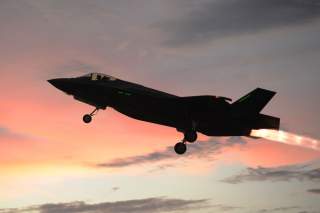Russia Thinks America's Stealth Fighters Are "Paper Fiction"
They really don't fear the F-35?
The Russians suggested that they could use alternatives to high-frequency fire control bands (C, X and Ku) to launch a missile at an F-22 or F-35.
Why is the Kremlin investing billions of dollars (rubles) into the Sukhoi PAK-FA fifth-generation fighter and the PAK-DA stealth bomber if Moscow considers stealth technology to be useless?
Recently, in response to a column I wrote, Russian media denounced stealth technology as useless—asserting that aircraft such as the Lockheed Martin F-22 Raptor or F-35 Joint Strike Fighter (JSF) would easily fall prey to advanced Russian-built air defenses. The column clearly struck a nerve with Russia’s air defense experts. Indeed, former chief of staff of Russia’s air defense forces, Col. Gen. Igor Maltsev, told Gazeta.ru that stealth technology was “paper fiction.”
(This first appeared in August 2016.)
Nonetheless, the Russians continue to spend billions of dollars developing stealth technology for the PAK-FA, PAK-DA and the Kh-101 and Kh-102 cruise missiles—the later of which is crucial for securing Moscow’s strategic nuclear deterrence. But if stealth technology were ‘paper fiction’—why would Moscow pour billions down the drain for no good reason?
“Low observation is far short of invisibility, but if this element of fifth-generation aircraft technology is 'paper fiction,' then why is Russia building the PAK-FA, dreaming about the PAK-DA, and the same can be said of Chinese prototypes in development,” said Michael Kofman, a research scientist at CNA Corporation specializing in Russian military affairs—who alongside myself—was shall we say, vigorously analyzed by Russian media. “Surely they are not simply competing with the JSF for who can spend the most money.”
The Russians suggested that they could use alternatives to high-frequency fire control bands (C, X and Ku) to launch a missile at an F-22 or F-35. Those alternatives include command guidance, infrared, optical and other options. Indeed, the Russians could attempt to do so—but while command guidance is fairly common—there are no operational long-range area air defense systems that feature infrared or optical guidance.
Infrared and optical guidance are only effective at relatively short-ranges. The Russians would have to use low-frequency radar to guide a missile equipped with an infrared or optical sensor into range if such a such a system were to be developed. However, analysts and defense officials said that such a system could be overcome by changing tactics.
Indeed, as I have written here in The National Interest and at Aviation Week & Space Technology, there are some Western experts such as Col. Michael Pietrucha who have theorized potential ways to engage stealth aircraft using VHF and UHF-based radars. However, as several U.S. Air Force experts on stealth technology and tactics have told me, while Pietrucha’s idea might work theoretically, it would probably not work in practical terms.
“Although I can't argue with the specifics—it's all basic physics—I think it is reaching to say that high-band stealth is ‘for naught.’ At the end of the day, almost all of the current shooters are targeted by our current stealth. Newer systems may be developed to hit gaps, but we still have a head start,” one highly experienced U.S. Air Force stealth expert told me. “Plus, we never go alone. EW [electronic warfare] is another game, and there are systems tailored there as well. As for active missiles, good luck fitting a VHF antenna in a missile body.”
Thus, even if high-frequency stealth might not be as effective today as it was in the immediate aftermath of the Soviet collapse, Moscow probably has not developed an effective countermeasure to defeat the F-22 or F-35 just yet.
Even if the Kremlin had found a way to defeat American low observable technology, it would be imprudent for Moscow to telegraph that message to its opponents in Washington. Moreover, it would be doubly irresponsible to squander billions of dollars on a fool’s errand to develop a technology that one believes to be obsolete or “paper fiction” as the case may be—especially during a time of economic hardship.
Thus, the very fact that Russia is investing in the PAK-FA and PAK-DA is ample evidence that stealth not only works but is also here to stay. Otherwise, why bother?
Dave Majumdar is the defense editor for the National Interest. You can follow him on Twitter: @davemajumdar.
Image: U.S. Department of Defense

